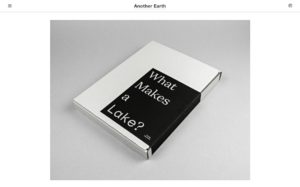
I’m honored to be part of this beautiful publication “What Makes a Lake? Tracing Movement” by Another Earth. A photo from my photo series “Wintertag” and a text about Lake Yamanaka in the Fuji Five Lakes has been featured in this book. Thank you so much for including my work.
What Makes a Lake? Tracing Movement brings together the work of more than 80 artists to create a portrait of Earth’ lakes, rivers, and oceans. This collection of images and text offers an intimate experience of places that we hope create a new connection to and commitment for caring for our most vulnerable ecosystems. In exploring an expanded scope of lakes around many different communities, we see how all these bodies of water are not isolated but rather flowing in and out of one another, reminding us how much our impact ripples out. What changes can be made with new awareness? (via Another Earth website)
Available for preorder Sold out ▶︎ Another Earth “Books”
First edition of 150 copies. US$45 + Shipping fee.
Another Earth is an independent publisher based in Vermont, US and Toronto, Canada.
Founders: Abbey Meaker, Cristian Ordóñez, and Estefania Puerta.
This publication was supported by the Burlington City Arts Community Fund Grant.

都市から郊外への人口流出や気候変動の影響を受けている自然界。地球の地殻変動の歴史が刻まれている湖とその川、そこに住まう生態系などに焦点を当て、様々な考察を促すAnother Earthのプロジェクト「What Makes a Lake? Tracing Movement」。その本に、「Wintertag」シリーズの写真とその舞台でもある地元相模川の源流・山中湖に関するテキストが選出されました。
アカデミックなテーマでリサーチベースのプロジェクトが多くを占める印象もある欧米ファインアート界の方達で今回個人的に目に留まったのは、フランスのアートスクール講師でキュレーター、ビエンナーレのアートディレクターで写真家でもあるPh.D. Anne Immeléさんが選出されていたことです。Black Flower Publishingの創始者Will Sharp、Too Tired ProjectのディレクターKelly Burgess、その他にもCasey Bennett、Kate Schneider、Giuseppe De Santis、Kalie Krauseなど掲載者は80名弱。Cristian OrdóñezさんとAbbey Meakerさんによるブックデザインも含めて、元々勉強目的でこの本の企画に興味があったので、七月九月を楽しみに待ちたいと思います(先行予約開始後三日間でソールドアウト)。掲載された写真とテキストは以下(Continue reading)に転載します。

At the foot of Mount Fuji, there are five lakes that are all lava-dammed bodies of water formed when Mount Fuji erupted in 800 AD. The highest-lying is Lake Yamanaka, which freezes over in winter and is the only one to be drained by a natural river. The river emerges from Lake Yamanaka bearing meltwater and runs in a large arc 70 km northeast to where I live in the central part of Kanagawa Prefecture, before heading straight down south and finally reaching the Pacific. The river flowing through my home area is called the Sagami, and it is well known as a site for catching natural sweetfish. In winter, people climb into boats, make holes in the ice layer over the lake and fish for smelt. Smelt, marimo (algae) and released basket clams live in Lake Yamanaka, but, in recent years, sludge accumulating on the lake bottom has led to a decrease in the weight of the clam harvest.
2023 ©︎ Masato Ninomiya. Edited by Another Earth.
脚注 1)本への掲載(写真画像及びテキスト)については合意書に著名を行なっています。掲載テキストは、今回新たに記した山中湖に関するリサーチであり、「Wintertag」シリーズのアーティスト・ステートメントではありません。
脚注 2)本のレイアウト上、テキストは双方合意の上でAnother Earthによる編集が入っています。要約前の第一稿ドラフトは以下に転載します。ドラフトには富士山の世界遺産登録の際に観光客増加によるゴミ投棄問題が挙げられたことや、近年シジミの収穫量が減少している山中湖では水質調査が行なわれていることも含めていました。ドラフトの英翻訳には懇意にさせて頂いているイギリスの翻訳家、古橋佳子さんとマイケル・ノーモイルさんのご協力を得ています。
At the foot of Mount Fuji, one of Japan’s most outstanding natural features, there are five lakes. These are all lava-dammed bodies of water formed when Mount Fuji erupted in 800 AD. The highest-lying is Lake Yamanaka, which freezes over in winter and is the only one to be drained by a natural river. The river emerges from Lake Yamanaka bearing meltwater and runs in a large arc 70 km northeast to where I live in the central part of Kanagawa Prefecture, before heading straight down south and finally reaching the Pacific. The river flowing through my home area is called the Sagami, and it is well known as a site for catching natural sweetfish. The waters of Lake Yamanaka are beautiful. In winter, people climb into boats, make holes in the ice layer over the lake and fish for smelt. A little-known fact about this beautiful natural lake is that it has a serious water pollution problem. Smelt, marimo (algae) and released basket clams live in Lake Yamanaka, but, in recent years, sludge accumulating on the lake bottom has led to a decrease in the weight of the clam harvest. Before it was registered as a World Heritage site, the Mount Fuji area had seen problems such as tourism growth and left-behind garbage emerge as environmental protection concerns. Water quality in Lake Yamanaka is surveyed whenever necessary.
2023 ©︎ First draft by Masato Ninomiya. Translated by Yoshiko Furuhashi and Michael Normoyle at M&Y Translations (UK).